Since I started my journey in the world of multi-rotors I hesitated to make reviews on hexas, don’t ask me why because I can’t specify any real reason. It looks like 2016 changed my appetite because this LiDi RC L6F will be the second hexa copter that I reviewed this month :).
Theoretically, hexacopters have all the benefits of motors plus some extras: greater overall performance (more motors can generate more lifting power), faster flight speed and higher elevation. Through a good 6-motor design and a smart flight controller, it is possible to obtain some redundancy in case of motor failure. This means that the operator will be able to land the aircraft if one motor, or even two, is/are out! Of course, this LiDi RC L6W hexacopter is just a remote-controlled toy and we should not expect any safety features due to the additional motors.
LiDi RC L6 series has three different models:
- L6 – basic model, without camera or FPV;
- L6W – with 2MP WIFI FPV camera;
- L6F – with 2MP 5.8GHz FPV camera and 4.3″ FPV screen.
The LiDi RC L6W is cheaper at about $ 15 than the 5.8GHz version and, unlike the L6F, it requires a smartphone to display the real-time video feed from the on-board camera.
LiDi RC L6F review
When I was contacted by Elliot from Gearbest to review their new hexacopter I had to choose between the WiFi and 5.8 GHz version. Finally, I opted for the 5.8 GHz model because I was curious whether it adopts a non standard protocol or it can be used together with any other FPV screens or FPV goggles. BTW the LiDi RC L6F is available in two colors, black piano and shiny blue.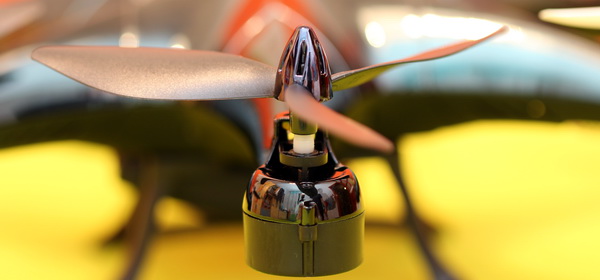
According to the advertised specs, this hexa-copter has about 8 to 10 minutes of play time and nearly 100 meters of control range. I do not know (yet) how accurate are these values considering that on those specs it should be sold with an 800 mAh and I receive it with a 750 mAh one…
LiDi RC L6F highlights
- 6 motor design;
- 3 blade propellers;
- Headless flight mode;
- One key return to home;
- 2MP camera for videos and photos;
- Adjustable lens angle;
- Complete 5.8GHz real-time image transmission;
- The LED lights can be remotely turned ON/OFF;
- “Low”, “Medium”, and “High” speed rates;
- Possible altitude-hold on an upgrade version.
LiDi RC L6: First impressions
I received the package in about 15 days after we agreed on the review. When I inspected the box at the postal office, I observed an approximate 4 x 3 cm hole in it. It is probably the result of the “carefully” handling. Knowing that there is no point in submitting a complaint, I went home hoping that any part of the content was not damaged.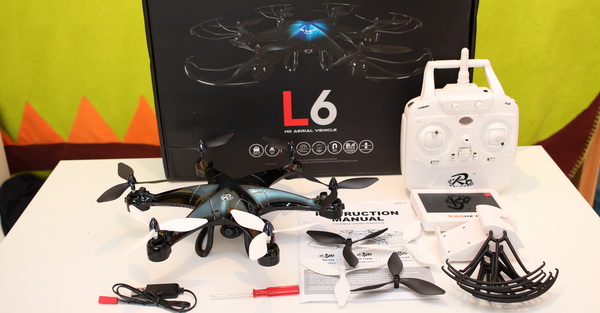
I was lucky, visually inside, everything seemed to be unharmed. To check it, I immediately loaded 4 pieces of AA batteries into the RC, and I plugged the Li-Po battery into the L6F’s JST socket.
After the regular binding process, I pushed up with confidence the throttle stick but surprise… instead of flying straight up, it began to fly on the right until overturned.
When a multi-rotor starts to behave strangely it is best to check the propellers and perform a re-calibration. In the case of the L6F hexacopter, the gyro calibration can be performed by pushing both sticks in the same time to the lowest-left position.
After the restart sequence finished, I made a second attempt to take off. This time everything was fine, it worked like a charm.
Sorry, I rushed, and I almost forgot to describe the package content. Besides the aircraft and its remote controller, I found in the box the following:
- 4.3″ 5.8 GHz FPV screen;
- 5.8 GHz FPV HD camera with recording function;
- 750 mAh Li-Po battery;
- USB battery charger;
- Screen holder;
- 1 set of propeller guards;
- four pieces of spare propellers (two white and two black);
- Screwdriver and screws;
- L6F user manual (Chinese and English).
Excepting the propeller guards, all the rest were installed on the aircraft (camera, propellers and landing skids).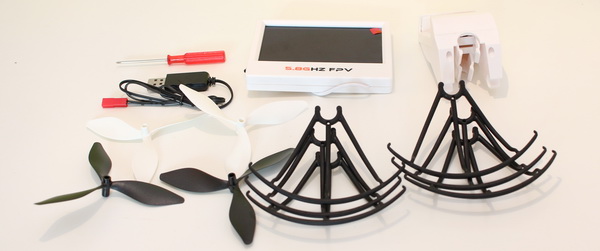
Newbies should consider installing the blade guards before their first flight. The installation process is straightforward and takes only about 5 minutes.
To have a clear view of the position (orientation) of the aircraft, it is equipped with two white propellers in front and black in the rest. For the same reason under the front arms are white LED lights while under the rest of the arms, there are green LEDs.
The FPV screen holder has a clip-on mounting system and can be easily attached to the remote controller without using any tool. The same kind of holder is provided with the LiDi RC L6W for the purpose of installing a smartphone on the top of the remote controller.
LiDi RC L6F: Camera
The camera of this aircraft has a similar design to the one Syma X5C models have. The only visual difference is a small 5.8 GHz antenna on the right side of the housing that ensures real-time image transmission. I can confirm that the camera uses a standard 5.8 GHz channel and protocol. I got a clear and steady live video feed on my Eachine LCD5802S FPV screen.
The camera is capable of recording videos with 1280 x 720 HD resolution at 30 fps and 16-bit mono audio. My 60 seconds test video occupied about 120MB on the micro SD memory card.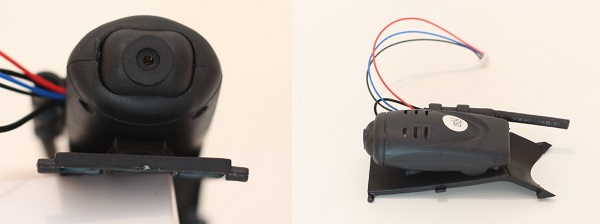
The captured photos have 1600 x 1200 pixels and are stored in JPEG compressed image format. Reading the EXIF data, I found out that the photos are captured by a “Syntek USB camera” with 6 mm focal length at ISO-100.
Later I will upload some sample videos that show the image quality of the recording.
LiDi RC L6F: Remote controller
All 3 models of the LiDi RC L6 series have the same kind of remote controller, but for example, the L6W has a black one while the L6F has a white one (as shown in the image below).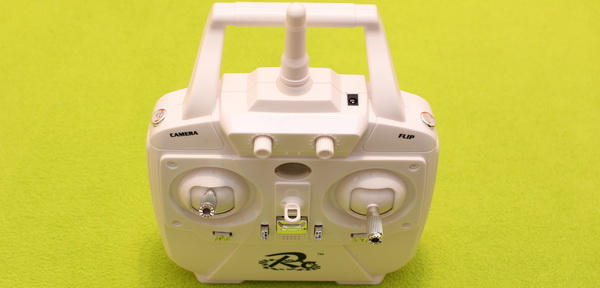
On the upper part of the transmitter, there are two fake gimbal knobs which, I suppose, are there in order to provide a more professional look.
As I previously mentioned, the FPV display is installed on top of the transmitter. Both RC and FPV screens are powered by the same 4 pieces of AA batteries which I think will decrease dramatically the operation time.
By short pressing the top-left button the camera will take a photo and by long pressing it will start or stop the video recording. By pressing the left stick (throttle) as a button, you can activate the headless flight mode. With the same technique through the right stick, you can engage the return to home function.
Switching between “Low”, “Medium” and “High” speed rates can be made using the trim button located on the left side of the ON/OFF switch.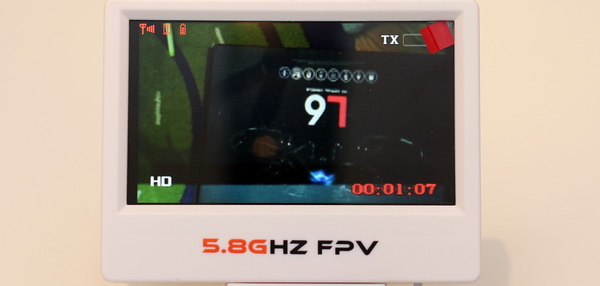
LiDi RC L6F review: Flight performance
The battery came almost empty, so my first flight was about 2 minutes. After a “quick” recharge, which takes about 70 minutes with the included USB charger, I was ready for a second try. The aircraft is small enough to be tested indoors, where it behaves very well, is stable, and responds accurately to the controls.
Outdoors, it is the same thing; very stable and easy to control. The first-person view system is quite usable, but I missed a sunshade.
When the aircraft flies out of the controller’s range, the motors are stopped within 2 seconds.
LiDi RC L6F range test video
Unfortunately, this aircraft doesn’t have altitude hold so you will have to play with the throttle stick to keep it on the desired height. Although I’m not interested in the “RTH”, I tested it, and I can say that the “one key return to home” feature performs very well.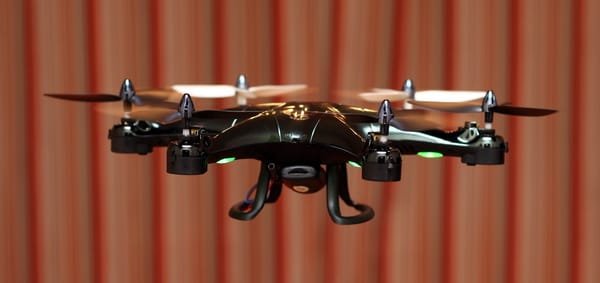
Pricing and availability
Thanks again, Gearbest, for their support in letting me review this nice product. Those interested in giving it a try for this hexa, can be ordered from for $89.99. A good tip, the blue one is cheaper at $3.25, and I think it looks even better :). 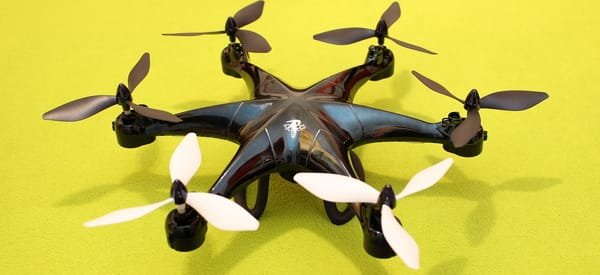

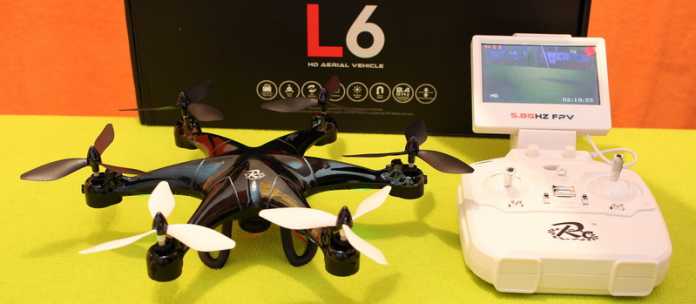
I had problems from the start, then two engines were burned and one of them stayed glued to the base and can not find LiDi RC L6F spare sparts.
Needed help me find the spare motors and base.
Please if someone sends me the link of these two pieces?.